When we think of carnivorous beings, images of large fangs and sharp claws come to mind. But what about carnivorous plants? Even though their name indicates that they are carnivorous, the vast majority only feed on insects.
There are around 700 species of carnivorous plants and some of them can hunt animals larger than insects, such as rats, frogs, or lizards. You might wonder, how can these plants trap prey? The surface of their leaves is extremely sensitive. Therefore, any pressure triggers a change in the water pressure of the leaf cells. That change translates into movement. The cells expand or contract and cause motion. That’s how their mouths open and close, or how their tentacles extend and trap their prey.
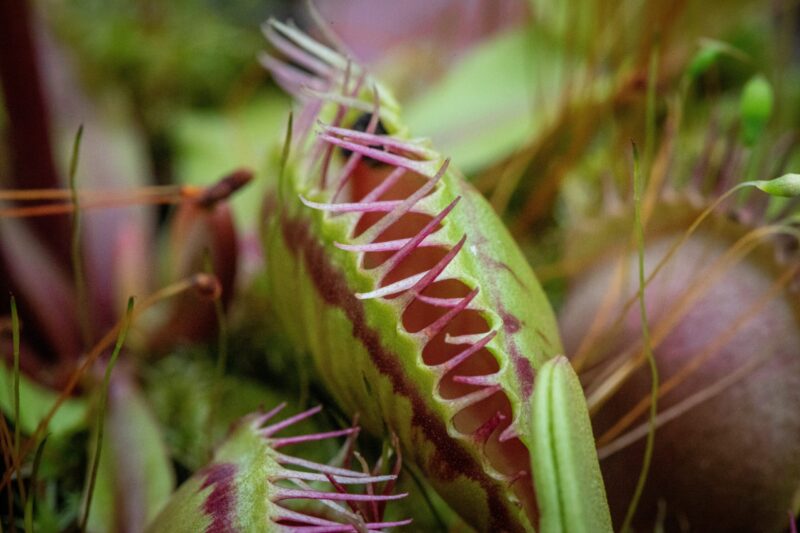
They are classified into five groups depending on the way they capture their prey.
Snap traps
Snap traps close their “mouths.” They are probably the most well-known type of carnivorous plant. Snap trap plants have leaves for mouths that release nectar on their edges to attract prey. When the prey approaches and touches the hairs or filaments inside the mouth, it closes, trapping the prey.
The Venus flytrap is one of the most famous carnivorous plants and is a snap trap plant. It has sensory hairs or filaments inside the mouth – between three and six on the surface of each leaf – that indicate to the leaf when to close. So, yes! Plants also produce electrical signals even though they lack a nervous system. The mouth only closes when the prey touches the filaments at least twice in less than 20 seconds, so as not to confuse it with a drop of water.
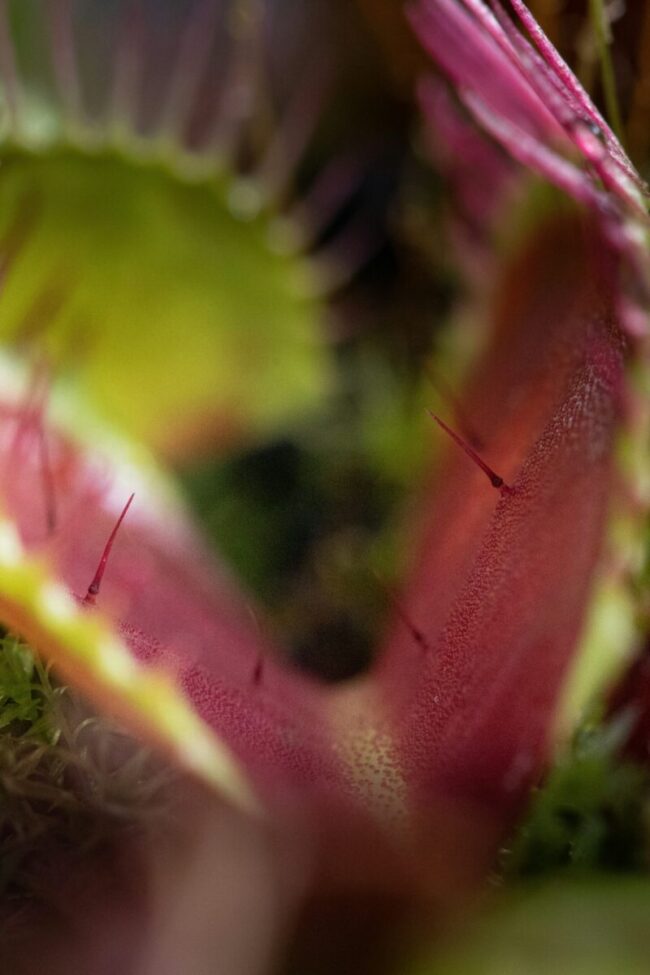
Sticky traps
Sticky traps (or flypaper traps) have leaves with hairs or filaments that produce nectar – that looks like dew or water drops at the top of the hairs – to attract prey. But this nectar is also sticky like glue. When the prey, attracted by the nectar, gets to the plant, it is trapped by the glue. Some plants have tentacle-like leaves that not only have the sticky filaments, but that can also wrap around the prey like an octopus.
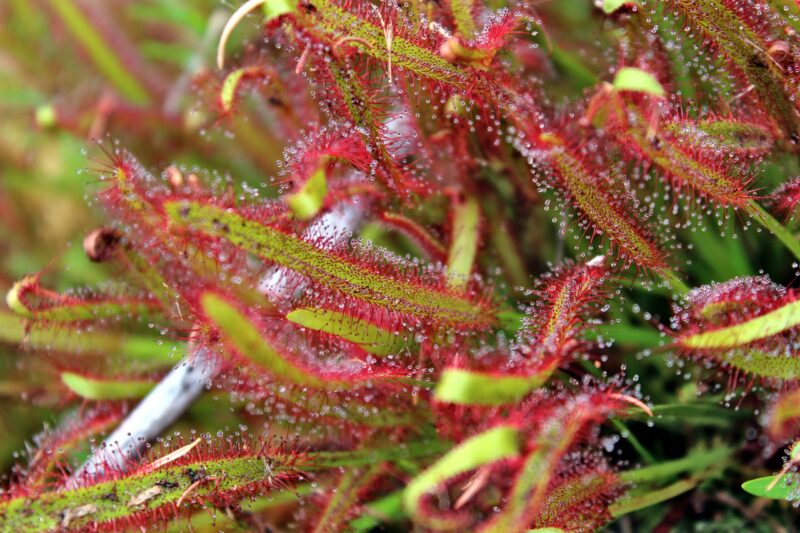
Pitcher plants
Pitcher plants (or pitfall traps) are jug-shaped and possess an incredible structure. Some of them have tendrils that fall down, then turn back up and transform into leaves that are completely closed at the bottom. The bottom of the jug fills with sweet, delicious nectar to attract prey. And it also fills with digestive enzymes to decompose prey. Also, these plants have a lid at the top. When they are digesting their prey, the lid closes.
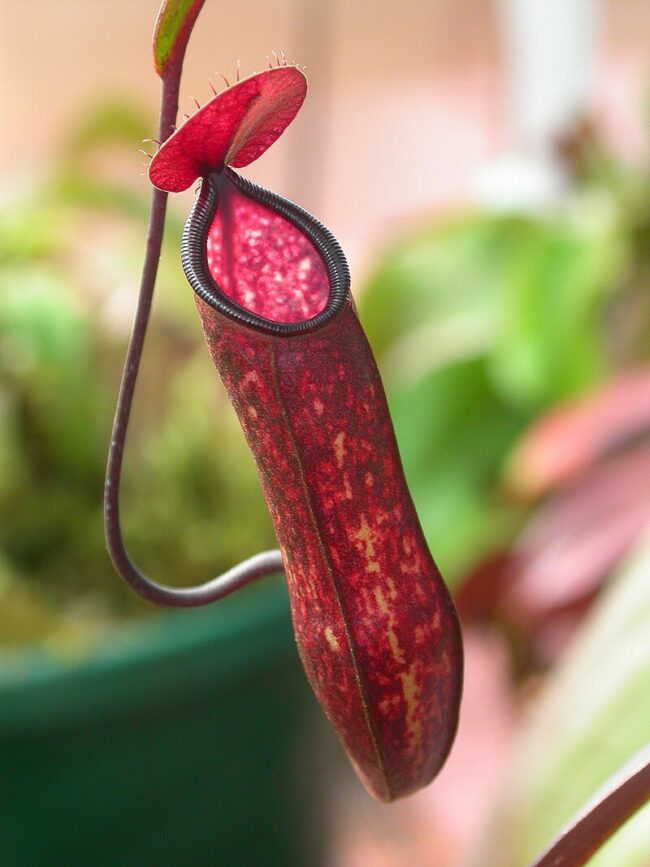
Light trap
A light trap (or lobster trap) plant also attracts prey with nectar, which is located at the bottom. In this case, the prey enters the plant, that has sort of a window that allows light to enter the plant. The prey gets deeper into the plant, following the light and the nectar, and can’t find the way back to the dark entry.
Inward hairs
Inward hairs (or pigeon traps) have hairs where the prey enters. Once inside the trap, the prey can’t escape past the hairs.
How is prey digested?
Carnivorous plants produce nectar to attract prey, then use acids to dissolve their victims, and enzymes to digest them. Enzymes are a type of protein that act as catalysts and regulators of chemical reactions.
Once the plant begins to produce digestive enzymes to decompose and digest the prey, there are other glands in the plant that begin to function. They absorb the solution that has been produced, and with it, the nutrients that the plant needs. Not a drop is wasted in the entire process.
How long does it take to digest its prey?
The most curious thing about these plants is that it can take more than two weeks for them to digest any insect, while humans only need about two days to completely digest food.
But even if their digestion is slow, the mouths and lids are quite fast! According to a study from the National Institute of Health:
It was shown using high-speed video under ultraviolet light that the fast closure of Venus flytrap starts at about 40 milliseconds after mechanical stimulation and completes in 0.3–0.7 s.
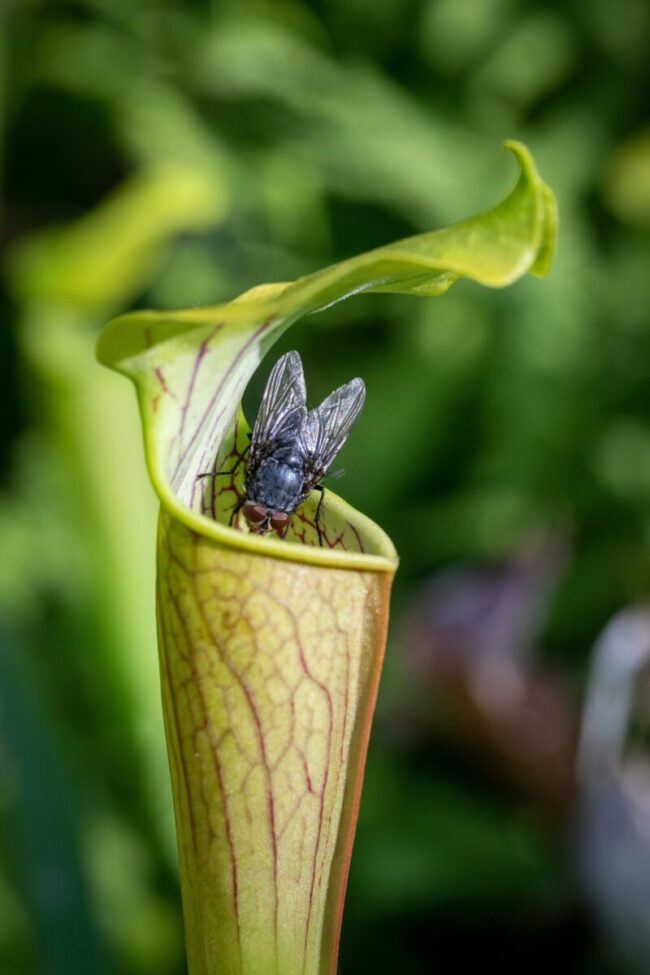
How did they become carnivorous?
Let’s not forget that, in the end, these carnivorous plants are still plants. So, yes, they do go through a normal photosynthesis process, which converts light into chemical energy. This process requires not only sunlight, but also water, carbon dioxide, and nutrients such as nitrogen. But carnivorous plants usually live in swampy places, such as bogs and wetlands, areas that have little nitrogen and an acidic pH. That’s why they evolved into carnivores.
Plants get nutrients from the soil through their roots. But if the soil quality isn’t good enough, with areas low in nitrogen, then the carnivorous plants need to supplement nitrogen by eating insects or animals.
But trapping and digesting prey require energy, which leaves less energy for photosynthesis. Consequently, carnivorous plants photosynthesize at significantly lower rates than regular plants. Still, these plants need ample sunlight.
Curious things about them
Most carnivorous plants respect pollinating insects. Like many other plants, carnivorous plants need pollinators, though some carnivorous plants can self-pollinate. If carnivorous plants feed on insects, how do they differentiate pollinators from non-pollinators? That’s where the magic of nature comes in to play.
Logically, the plants don’t know which insect is approaching. So, they grow a very long stem, far away from their traps, and right at the top, there is an attractive flower for the beloved pollinators.
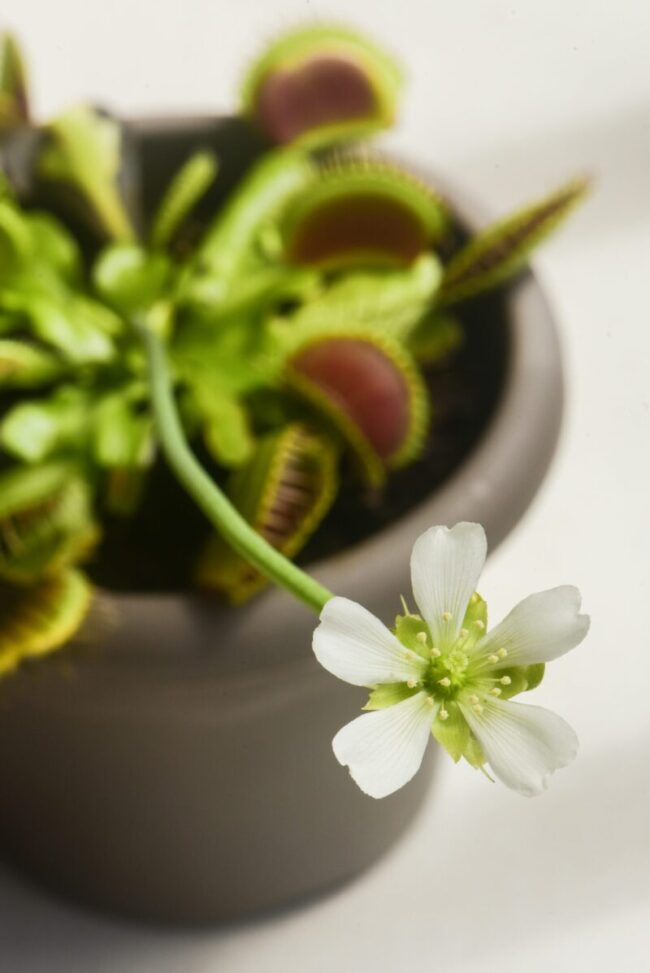
Some even hibernate
Some carnivorous plants of tropical origin hibernate during winter. Although their behavior varies depending on the species, they usually shed their leaves to sprout again with the arrival of spring. This is a protective mechanism that enables the plant to survive in various climates. So, if you have one and it stops growing in winter, now you know why.
There are some species that live submerged in water. In this case, the base of the plant is submerged while the stems with traps are on the surface. How cool! This is how they feed.
Can you grow them at home?
Although they are wild plants, if you replicate the conditions in which they live, they can be grown at home. Study the type of plant and its needs before purchasing one. These plants are delicate and require specific care. You should know that some carnivorous plants survive well in cold climates, but the vast majority live in tropical and humid climates.
The soil for carnivorous plants should have few nutrients and not be fertilized. Make sure the plant has enough humidity and plenty of sunlight. If you live in a cold place, it is advisable to keep the plant indoors and create a small greenhouse to maintain humidity and warmth.
Instead of watering it from the top, place a deep container of water under the pot and let it absorb water. When the surface of the pot is wet, you can remove the container. Use distilled water or rainwater to avoid any additives found in tap water.
The plant’s feeding habits depend on the type of plant. Keep in mind that some species ONLY need sunlight and water to live.
When the plant moves, like when closing its mouths, it uses a lot of energy. So don’t play with your plant to make it close its mouths on purpose, it will lose a lot of energy and won’t receive any nutrients. It needs that energy to survive.
In many cases, you won’t have to feed it because the plant has its own system for attracting insects. If your plant is indoors and doesn’t have access to any insects, you can feed it, but take into account that it may take up to two weeks for your plant to digest the insect you offer it.
Read more: Water lilies, beautiful and colorful: Lifeform of the week
Bottom line: Beware of carnivorous plants! There are hundreds of species and they are deadly, but mostly to insects. The structure of their traps is foolproof.
The post Carnivorous plants are our lifeform of the week first appeared on EarthSky.
from EarthSky https://ift.tt/oXzjvwr
When we think of carnivorous beings, images of large fangs and sharp claws come to mind. But what about carnivorous plants? Even though their name indicates that they are carnivorous, the vast majority only feed on insects.
There are around 700 species of carnivorous plants and some of them can hunt animals larger than insects, such as rats, frogs, or lizards. You might wonder, how can these plants trap prey? The surface of their leaves is extremely sensitive. Therefore, any pressure triggers a change in the water pressure of the leaf cells. That change translates into movement. The cells expand or contract and cause motion. That’s how their mouths open and close, or how their tentacles extend and trap their prey.

They are classified into five groups depending on the way they capture their prey.
Snap traps
Snap traps close their “mouths.” They are probably the most well-known type of carnivorous plant. Snap trap plants have leaves for mouths that release nectar on their edges to attract prey. When the prey approaches and touches the hairs or filaments inside the mouth, it closes, trapping the prey.
The Venus flytrap is one of the most famous carnivorous plants and is a snap trap plant. It has sensory hairs or filaments inside the mouth – between three and six on the surface of each leaf – that indicate to the leaf when to close. So, yes! Plants also produce electrical signals even though they lack a nervous system. The mouth only closes when the prey touches the filaments at least twice in less than 20 seconds, so as not to confuse it with a drop of water.

Sticky traps
Sticky traps (or flypaper traps) have leaves with hairs or filaments that produce nectar – that looks like dew or water drops at the top of the hairs – to attract prey. But this nectar is also sticky like glue. When the prey, attracted by the nectar, gets to the plant, it is trapped by the glue. Some plants have tentacle-like leaves that not only have the sticky filaments, but that can also wrap around the prey like an octopus.

Pitcher plants
Pitcher plants (or pitfall traps) are jug-shaped and possess an incredible structure. Some of them have tendrils that fall down, then turn back up and transform into leaves that are completely closed at the bottom. The bottom of the jug fills with sweet, delicious nectar to attract prey. And it also fills with digestive enzymes to decompose prey. Also, these plants have a lid at the top. When they are digesting their prey, the lid closes.

Light trap
A light trap (or lobster trap) plant also attracts prey with nectar, which is located at the bottom. In this case, the prey enters the plant, that has sort of a window that allows light to enter the plant. The prey gets deeper into the plant, following the light and the nectar, and can’t find the way back to the dark entry.
Inward hairs
Inward hairs (or pigeon traps) have hairs where the prey enters. Once inside the trap, the prey can’t escape past the hairs.
How is prey digested?
Carnivorous plants produce nectar to attract prey, then use acids to dissolve their victims, and enzymes to digest them. Enzymes are a type of protein that act as catalysts and regulators of chemical reactions.
Once the plant begins to produce digestive enzymes to decompose and digest the prey, there are other glands in the plant that begin to function. They absorb the solution that has been produced, and with it, the nutrients that the plant needs. Not a drop is wasted in the entire process.
How long does it take to digest its prey?
The most curious thing about these plants is that it can take more than two weeks for them to digest any insect, while humans only need about two days to completely digest food.
But even if their digestion is slow, the mouths and lids are quite fast! According to a study from the National Institute of Health:
It was shown using high-speed video under ultraviolet light that the fast closure of Venus flytrap starts at about 40 milliseconds after mechanical stimulation and completes in 0.3–0.7 s.

How did they become carnivorous?
Let’s not forget that, in the end, these carnivorous plants are still plants. So, yes, they do go through a normal photosynthesis process, which converts light into chemical energy. This process requires not only sunlight, but also water, carbon dioxide, and nutrients such as nitrogen. But carnivorous plants usually live in swampy places, such as bogs and wetlands, areas that have little nitrogen and an acidic pH. That’s why they evolved into carnivores.
Plants get nutrients from the soil through their roots. But if the soil quality isn’t good enough, with areas low in nitrogen, then the carnivorous plants need to supplement nitrogen by eating insects or animals.
But trapping and digesting prey require energy, which leaves less energy for photosynthesis. Consequently, carnivorous plants photosynthesize at significantly lower rates than regular plants. Still, these plants need ample sunlight.
Curious things about them
Most carnivorous plants respect pollinating insects. Like many other plants, carnivorous plants need pollinators, though some carnivorous plants can self-pollinate. If carnivorous plants feed on insects, how do they differentiate pollinators from non-pollinators? That’s where the magic of nature comes in to play.
Logically, the plants don’t know which insect is approaching. So, they grow a very long stem, far away from their traps, and right at the top, there is an attractive flower for the beloved pollinators.

Some even hibernate
Some carnivorous plants of tropical origin hibernate during winter. Although their behavior varies depending on the species, they usually shed their leaves to sprout again with the arrival of spring. This is a protective mechanism that enables the plant to survive in various climates. So, if you have one and it stops growing in winter, now you know why.
There are some species that live submerged in water. In this case, the base of the plant is submerged while the stems with traps are on the surface. How cool! This is how they feed.
Can you grow them at home?
Although they are wild plants, if you replicate the conditions in which they live, they can be grown at home. Study the type of plant and its needs before purchasing one. These plants are delicate and require specific care. You should know that some carnivorous plants survive well in cold climates, but the vast majority live in tropical and humid climates.
The soil for carnivorous plants should have few nutrients and not be fertilized. Make sure the plant has enough humidity and plenty of sunlight. If you live in a cold place, it is advisable to keep the plant indoors and create a small greenhouse to maintain humidity and warmth.
Instead of watering it from the top, place a deep container of water under the pot and let it absorb water. When the surface of the pot is wet, you can remove the container. Use distilled water or rainwater to avoid any additives found in tap water.
The plant’s feeding habits depend on the type of plant. Keep in mind that some species ONLY need sunlight and water to live.
When the plant moves, like when closing its mouths, it uses a lot of energy. So don’t play with your plant to make it close its mouths on purpose, it will lose a lot of energy and won’t receive any nutrients. It needs that energy to survive.
In many cases, you won’t have to feed it because the plant has its own system for attracting insects. If your plant is indoors and doesn’t have access to any insects, you can feed it, but take into account that it may take up to two weeks for your plant to digest the insect you offer it.
Read more: Water lilies, beautiful and colorful: Lifeform of the week
Bottom line: Beware of carnivorous plants! There are hundreds of species and they are deadly, but mostly to insects. The structure of their traps is foolproof.
The post Carnivorous plants are our lifeform of the week first appeared on EarthSky.
from EarthSky https://ift.tt/oXzjvwr

Aucun commentaire:
Enregistrer un commentaire